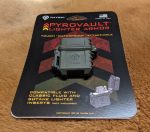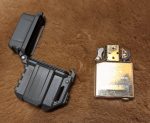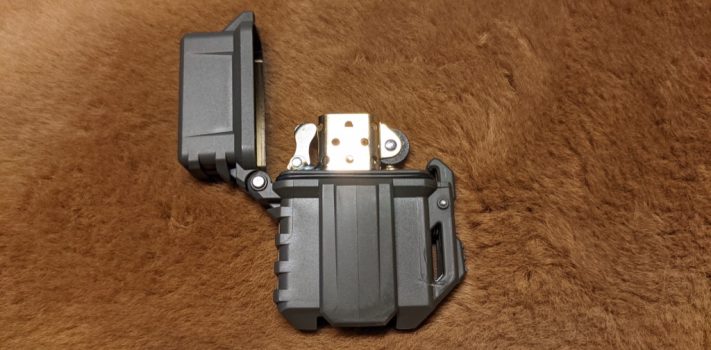Thyrm Pyrovault Lighter Armor encloses a Zippo lighter insert in a sturdy waterproof polymer case. In addition to making the insert waterproof, the case slows fuel evaporation from classic liquid-fuel inserts, so that the time between fillings can be measured in weeks rather than in days. The case can be opened and the insert operated with one hand. It greatly enhances the usefulness of the Zippo lighter insert.
At the time of this writing, the Pyrovault Lighter Armor was available from Thyrm for $29.99.
The Backstory
On October 10, 2021, SurvivalBlog published my article about using a sleeve cut from a bicycle inner tube to slow fuel evaporation from a classic Zippo liquid-fuel lighter.
After I submitted that article, I had a thought: “Someone ought to make a waterproof case for a Zippo lighter. That would both protect from moisture and slow fuel evaporation.” My next thought was, “Maybe someone already does.”
With that in mind, I did an internet search of “waterproof zippo lighter case.” I was happy to discover that the Thyrm company makes a “Pyrovault Lighter Armor” case that was just what I was looking for. I contacted the Thyrm company to find out if they could provide me with a sample for testing and evaluation. They were kind enough to agree. Two weeks later, a package arrived in the mail.
Why Zippo?
Fire is such an essential component of human comfort and survival, that I recommend that a person who sets out for the field carry at least three distinct methods of starting fires.
I recommend that one of these methods be a ferrocerium rod along with a number of pieces of waterproof tinder. In an article that was published in SurvivalBlog on June 6, 2021, I described how waterproof tinder can easily be made at home with cotton balls, paraffin, and petroleum jelly.
I recommend waterproof matches as another of these methods. They are relatively reasonably priced, and easy to use.
The third method will be dependent upon the conditions you expect to meet in the field. Butane lighters are highly effective under moderate conditions, but will not work if the temperature of the lighter drops below freezing. Electric plasma lighters are also highly effective under warmer conditions, but their effectiveness drops off in extreme cold. Permanent metal match lighters can be a good option for cold weather conditions with naphtha-based fuels. Zippo and IMCO-type lighters with naphtha-based fuels are also an effective alternative for cold weather conditions, although fuel depletion through evaporation can present a problem. That is why a method of slowing evaporation can be so significant.
Opening the Package
 The Pyrovault comes attached to a simple cardboard backing. The most attractive part of the packaging is the phrase “Made in USA” prominently displayed on the front. During this time when so many companies outsource their manufacturing overseas, Thyrm commendably still manufactures their products in the United States. I applaud Thyrm for their simple, straightforward packaging. I have often commented about how too many companies spend too much money on fancy packaging, and not enough on the product itself. Thyrm provides functional packaging that gives appropriate information about the product itself without distracting or diverting resources from the product.
The Pyrovault comes attached to a simple cardboard backing. The most attractive part of the packaging is the phrase “Made in USA” prominently displayed on the front. During this time when so many companies outsource their manufacturing overseas, Thyrm commendably still manufactures their products in the United States. I applaud Thyrm for their simple, straightforward packaging. I have often commented about how too many companies spend too much money on fancy packaging, and not enough on the product itself. Thyrm provides functional packaging that gives appropriate information about the product itself without distracting or diverting resources from the product.
When Thyrm agreed to send me the Pyrovault, I ordered a Zippo brass insert online. I subsequently found some complete Zippo lighters that were a little less expensive than the insert I had purchased. If I had searched more carefully, I could have saved a few dollars.
The Pyrovault comes with both a lanyard loop and a belt clip. The lanyard loop is large enough to accept a loop of paracord, which is my preferred lanyard. Under the Pyrovault lid is a rubber o-ring. An external latch holds the lid down firmly on the o-ring.
I placed the insert in the Pyrovault, and brought it out to the barn for testing.
Fuel Choices
 Classic Zippo liquid-fuel lighters can be fueled by kerosene, gasoline, and alcohol-based fuels as well as naphtha-based products. Probably the best alcohol-based fuel is “Denatured Alcohol Thinner and Marine Stove Fuel.” I have also successfully used 80% ethanol liquid hand sanitizer to fuel an IMCO lighter. During cold weather, the naphtha-based products ignite better at lower temperatures than other fuels. In addition to Zippo and Ronsonol lighter fluid, naphtha-based products include VM&P Naphtha Thinner and Coleman Camp Fuel (“white gas”). I happen to use Coleman Camp Fuel in my lighters, because I was able to buy it less expensively per ounce than the other options.
Classic Zippo liquid-fuel lighters can be fueled by kerosene, gasoline, and alcohol-based fuels as well as naphtha-based products. Probably the best alcohol-based fuel is “Denatured Alcohol Thinner and Marine Stove Fuel.” I have also successfully used 80% ethanol liquid hand sanitizer to fuel an IMCO lighter. During cold weather, the naphtha-based products ignite better at lower temperatures than other fuels. In addition to Zippo and Ronsonol lighter fluid, naphtha-based products include VM&P Naphtha Thinner and Coleman Camp Fuel (“white gas”). I happen to use Coleman Camp Fuel in my lighters, because I was able to buy it less expensively per ounce than the other options.
Testing
In the barn, I filled the insert in the Pyrovault with Coleman Camp Fuel using a Nalgene drop bottle. I did the same with a Zippo lighter for which I had made a sleeve cut from a section of bicycle inner tube. The sleeve-covered lighter was the one that I had tested for the previous fuel evaporation article mentioned above.
I laid both lighters on my work surface in the barn, and began a daily, side by side endurance test.
Initial Observations
 I found the Pyrovault to be much easier to use than the sleeve-covered Zippo. The Pyrovault was easy to open and ignite with one hand. The sleeve-covered Zippo required two hands to roll down the sleeve prior to opening the lid. One advantage held by the sleeve-covered Zippo was that it was easier to spin the flint wheel once the lid was opened. The latch for the Pyrovault sticks up from the lower case near the flint wheel. This makes it somewhat more difficult to get a good spin on the flint wheel of the insert in the Pyrovault.
I found the Pyrovault to be much easier to use than the sleeve-covered Zippo. The Pyrovault was easy to open and ignite with one hand. The sleeve-covered Zippo required two hands to roll down the sleeve prior to opening the lid. One advantage held by the sleeve-covered Zippo was that it was easier to spin the flint wheel once the lid was opened. The latch for the Pyrovault sticks up from the lower case near the flint wheel. This makes it somewhat more difficult to get a good spin on the flint wheel of the insert in the Pyrovault.
Long-Term Results
Every day from October 4, 2021 to Christmas Day 2021, with one exception, I ignited both of the lighters. The one exception was a day when I was out of town. On December 26, 2021, the Pyrovault lighter would no longer ignite.
I was really impressed. In my previous testing, the inner tube sleeve had only slowed fuel depletion through evaporation from 11 days without the sleeve to 57 days with the sleeve. An extension to 85 days represented a significant improvement.
However, it was only the Pyrovault that ran out of fuel after 85 days. The sleeve-covered Zippo continued to function. I continued with my testing.
Day after day, week after week, month after month, the sleeve-covered Zippo continued to ignite each day. I began to experience a sense of awe, periodically displaced by a sense of complacency.
The sense of awe came from the almost unbelievable endurance of the lighter. It reminded me of the eternal flame, or of the widow’s pot of oil in 2 Kings 4:1-7. It seemed almost miraculous.
The sense of complacency came precisely because the lighter ignited so boringly consistently for so long. As time went on, I occasionally had the feeling, “Of course the lighter will light today. It lit yesterday. It will light tomorrow. So shall it ever be, world without end, amen.”
And so from December 27, 2021 until May 28, 2022, I continued to ignite the sleeve-covered lighter each day with three exceptions. (I will tell you more about the exceptions later). Finally, on May 28, the fuel in the sleeve-covered lighter was expended.
I wondered how the lighter could endure for 238 days, when in my previous testing it had only lasted 57 days. I have come up with a two-faceted theory to explain this phenomenon.
The first facet of my theory relates to temperature. My testing for the previous article on evaporation was done during a period of hot weather. My testing for this article was done primarily during cold weather. I theorized that the hotter temperatures during the earlier test period resulted in faster fuel evaporation from the lighter.
The second facet of my theory relates to pliability. As I rolled down the rubber sleeve each day to ignite the lighter, the sleeve gradually became softer and more pliable. In its more pliable condition, it was better able to conform itself to the shape of the lighter, and create a closer seal, thus slowing evaporation.
Perhaps one or both of these facets of my theory are way off base, and the dramatic difference between the two test periods was due to some other factor. All I can say with confidence is that I got astoundingly good results during the second test period.
The Exceptions
There were three times between December 27 and May 28 when I was unable to test the lighter. The first of these exceptions occurred while I had Covid. There were two days while I was sick when I did not feel well enough to go out to the barn to test the lighter.
The second exception occurred while I was away on a winter retreat with the youth group from our church.
The third exception occurred when the flint on the lighter needed to be replaced. I did not have enough time to replace the flint the day that it ran out. So I missed a day of testing, until I replaced the flint the next day.
I thought that surely the process of replacing the flint would allow so much evaporation, that the fuel would be expended. I was wrong. The lighter continued to function for another 73 days after I replaced the flint.
The Winter Retreat
We left on Winter Retreat on a Friday afternoon. Skies were cloudy, with temperatures in the 40s if I remember right. As we drove north toward the camp where the Winter Retreat was to be held, it began to rain, and temperatures began to drop dramatically. Gradually the rain turned to ice and snow, and road conditions got really nasty. Our bus driver, the mother of some of the young people in our group, did an outstanding job of keeping the bus on the road and getting us safely to our destination.
One of our youth leaders pulled a trailer with our luggage up to camp behind his truck. Upon arrival, we discovered that the padlock on the trailer was frozen solid. Body heat from our hands was not sufficient to thaw it out. The plasma lighter that I always carry in my pocket could not generate enough heat to thaw out the lock. At that point, I longed for the Zippo that was sitting on the workbench in my barn. Heating a key with a lighter and then inserting it into a lock had proven effective at thawing locks in the past.
After continued diligent effort, the youth leader who towed the trailer up to camp finally managed to get the padlock opened. We then had a wonderful, very frosty, Winter Retreat, and returned happily to the church facility on Sunday afternoon.
Conclusions
Thyrum Pyrovault Lighter Armor significantly slows fuel evaporation from a Zippo lighter insert. It may or may not slow evaporation as much as a well-molded sleeve made from a bicycle inner tube. In any case, it is easier to operate with one hand than a sleeve-covered lighter, and more attractive in appearance.
Those who wish to use classic Zippo liquid-fuel lighters as one of their fire-starting methods will find the Pyrovault to be a significant upgrade over a standard Zippo lighter.
Disclaimer
Thyrum was kind enough to provide me with a sample of their Pyrovault Lighter Armor for testing and evaluation. I tried not to allow their kindness to influence my assessment of their product, and believe that I have succeeded in remaining objective.
I did not receive any other financial or other inducements to mention any vendor, product, or service in this article.










